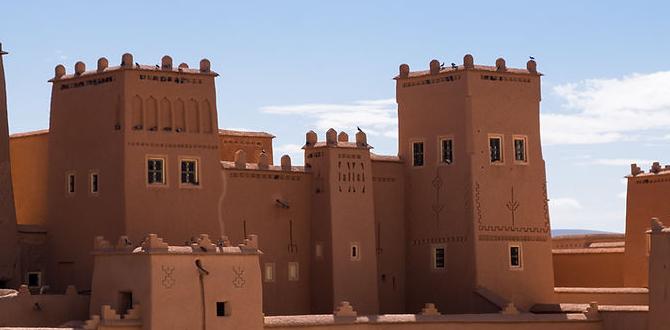Austria One Week Itinerary: A Proven Essential Guide for Stress-Free Exploration. Discover iconic cities, breathtaking landscapes, and cultural gems in just seven days with this practical, beginner-friendly plan.
Planning a week-long adventure in Austria can feel overwhelming. Where do you start? What are the must-sees? This guide is designed to take the stress out of it. We’ll help you craft an unforgettable Austrian journey, focusing on comfort, efficiency, and experiencing the best the country has to offer. Get ready for a seamless trip filled with culture, beauty, and delicious treats!
Frequently Asked Questions
- What’s the best way to get around Austria for a week?
- Austria has an excellent public transportation system. For a week-long itinerary, consider a combination of trains for inter-city travel and local buses or trams within cities. The Austrian Federal Railways (ÖBB) offers comfortable and efficient services. For longer distances and multiple trips, look into an Interrail Global Pass or a regional pass if it fits your specific travel plans.
- Is one week enough to see Austria?
- One week is a good amount of time to get a fantastic introduction to Austria’s highlights. You can comfortably explore one or two major cities and a scenic region. This itinerary focuses on that sweet spot, balancing immersion with efficient travel to maximize your experience.
- What’s the best time of year to visit Austria for a week?
- Austria is beautiful year-round! Spring (April-May) offers blooming landscapes and fewer crowds. Summer (June-August) is ideal for hiking and outdoor activities, though it can be warmer and busier. Autumn (September-October) brings stunning fall colors and harvest festivals. Winter (November-March) is magical for Christmas markets and winter sports. This itinerary is adaptable to any season.
- Do I need to book accommodations and train tickets in advance?
- It’s highly recommended, especially if you’re traveling during peak season (summer or around holidays). Booking accommodations and popular train routes a few weeks to months ahead can ensure you get the best prices and availability, and it reduces last-minute stress.
- What are the essential items to pack for a week in Austria?
- Pack layers! Comfortable walking shoes are a must, as you’ll be doing a lot of exploring. Include a waterproof jacket, a scarf, and gloves (even in spring/fall for mountains), your travel documents, a universal adapter, and any personal comfort items. For those needing them, discreet and comfortable adult or child diapers can provide peace of mind for extended travel days or unexpected situations, ensuring comfort and confidence throughout your journey.
- Can I travel to Austria with young children? What makes it easier?
- Absolutely! Austria is very family-friendly. Many attractions offer child discounts. Trains have space for strollers, and most hotels are accommodating. Packing essentials like snacks, comfort items, and, if needed, child diapers readily available can make a huge difference. Consider pacing your days to avoid over-scheduling young ones.
- What currency is used in Austria?
- The currency in Austria is the Euro (€). While credit cards are widely accepted in cities and larger towns, it’s always a good idea to have some cash on hand for smaller shops, markets, or rural areas.
Austria One Week Itinerary: Proven Essential Guide
Austria, a country often associated with majestic Alps, imperial history, and classical music, offers a rich tapestry of experiences. For those with only seven days, crafting an itinerary that captures its essence can seem like a grand challenge. This guide is your blueprint to a well-rounded, enjoyable, and stress-free week in Austria, perfect for first-time visitors and seasoned travelers alike. We’ll help you navigate between its vibrant cities and serene landscapes, ensuring comfort and delight every step of the way.
This “Austria One Week Itinerary” focuses on hitting the highlights without feeling rushed. We’ll explore iconic destinations, suggest efficient travel methods, and offer tips to make your journey smooth, even if you have specific personal needs like carrying adult diapers for extended flights or days out.
Planning Your Austrian Adventure
A successful week in Austria begins with smart planning. This involves understanding the best way to get around, where to stay, and what your must-see priorities are. Think of this as packing your travel essentials – the right preparation makes all the difference.
Transportation in Austria
Austria boasts an exceptional public transportation network. For a week-long itinerary that covers multiple locations, the train is your best friend. The Austrian Federal Railways (ÖBB) is renowned for its punctuality, comfort, and extensive coverage across the country.
- Trains: Ideal for traveling between cities like Vienna, Salzburg, and Innsbruck. Book tickets in advance, especially for high-speed Railjet services, to secure better fares.
- Buses: Useful for reaching smaller towns or scenic routes not covered by rail.
- Local Transport: Within cities, trams, buses, and metros are efficient and easy to use. Consider day passes or weekly passes for convenience.
For this itinerary, we’ll primarily rely on train travel for inter-city journeys to maximize your time and minimize travel fatigue.
Accommodation Tips
Austria offers a range of accommodations from luxury hotels to charming guesthouses and budget-friendly hostels. For a one-week trip, consider staying in well-located hotels or apartments in each city to easily access attractions and transportation hubs. Booking in advance is highly recommended, particularly during peak tourist seasons (summer and Christmas markets).
Estimating Your Budget
Austria can be moderately expensive, but with careful planning, it’s manageable. Key costs include:
- Accommodation: €70-€150+ per night for a mid-range hotel.
- Food: €40-€70 per person per day (mix of restaurants and casual eats).
- Transportation: €150-€250 for a week of inter-city train travel and local transport passes.
- Activities/Entrance Fees: €20-€50 per person per day, depending on your interests.
This is a general estimate. You can save by opting for picnics, utilizing free walking tours, and looking for city passes that often include transport and museum entries.
Your Austria One Week Itinerary: A Sample Journey
This itinerary is designed to give you a taste of Austria’s most celebrated destinations: the imperial grandeur of Vienna, the musical charm of Salzburg, and the picturesque beauty of the Austrian Alps. It balances iconic sights with opportunities to soak in the local atmosphere.
Days 1-3: Vienna – Imperial Elegance and Cultural Vibrancy
Your Austrian adventure begins in the magnificent capital, Vienna. Known for its imperial palaces, classical music heritage, and thriving coffee house culture, Vienna offers a full spectrum of experiences.
Day 1: Arrival and Imperial Grandeur
- Arrive at Vienna International Airport (VIE).
- Transfer to your hotel. Consider the efficient CAT (City Airport Train) or a direct train for easy access to the city center.
- Check in and leave your luggage.
- Begin with a stroll through the historic city center (Innere Stadt).
- Visit St. Stephen’s Cathedral (Stephansdom), an iconic Gothic masterpiece. Consider climbing the tower for panoramic city views.
- Explore the Hofburg Palace, the former imperial residence. You can visit the Imperial Apartments, the Sisi Museum, and the Silver Collection.
- Enjoy a traditional Viennese dinner and perhaps indulge in Sacher-Torte at Café Sacher.
Day 2: Palaces, Art, and Music
- Dedicate your morning to Schönbrunn Palace, the stunning summer residence of the Habsburgs. Explore the opulent rooms and wander through its vast Baroque gardens.
- In the afternoon, immerse yourself in art at the Kunsthistorisches Museum (Museum of Art History) or the Belvedere Palace, home to Gustav Klimt’s ‘The Kiss’.
- Experience Vienna’s musical heart by attending a classical concert. Many venues offer performances of Mozart and Strauss, a quintessential Viennese experience.
Day 3: Cultural Gems and Departure to Salzburg
- Visit the Spanish Riding School to witness the graceful Lipizzaner horses (check performance or morning exercise schedules).
- Explore the Naschmarkt, Vienna’s most famous market, for a taste of local produce, snacks, and diverse culinary options – a great spot for a casual lunch.
- In the afternoon, head to Vienna Hauptbahnhof (main train station) for your train journey to Salzburg. The journey takes approximately 2.5-3 hours.
- Arrive in Salzburg, check into your hotel, and take a relaxing evening walk along the Salzach River.
Days 3-5: Salzburg – Birthplace of Mozart and “Sound of Music” magic
Salzburg, nestled beside the German border, is a city that feels like it’s sprung from a fairytale. It’s renowned as the birthplace of Mozart and the iconic setting for “The Sound of Music.”
Day 3 Evening: Salzburg Arrival
- After arriving and checking into your hotel, enjoy an early dinner in the charming Old Town.
- Consider a leisurely walk to admire the illuminated Salzburg Cathedral.
Day 4: Old Town, Fortress, and Mozart
- Start your day by exploring Salzburg’s UNESCO World Heritage-listed Old Town (Altstadt). Wander its narrow, cobblestone streets, admire the Baroque architecture, and browse the unique shops on Getreidegasse.
- Visit Mozart’s Birthplace (Geburtshaus) at No. 9 Getreidegasse to learn about the life of the musical genius.
- Ascend to Hohensalzburg Fortress, one of Europe’s largest medieval fortresses, for breathtaking views of the city and surrounding Alps. Explore its museums and historic rooms.
- In the afternoon, visit Salzburg Cathedral, a magnificent Baroque landmark.
- Enjoy a traditional Austrian meal at a local Gasthof.
Day 5: “Sound of Music” Scenery or Alpine Escape to Innsbruck
You have a choice for Day 5:
- Option A (Sound of Music Focus): Take a “Sound of Music” themed tour. These tours are incredibly popular and will take you to many of the filming locations outside the city, offering stunning countryside views. This is a full-day commitment.
- Option B (Alpine Scenery & Travel to Innsbruck): If you prefer mountains and a different city, take a scenic train ride to Innsbruck. This journey is approximately 1.5-2 hours and offers spectacular alpine vistas.
If you choose Option B, arrive in Innsbruck, check into your hotel, and begin exploring the “Capital of the Alps.”
Days 5-7: Innsbruck – Capital of the Alps and Departure
Innsbruck, the capital of Tyrol, is set amidst dramatic snow-capped peaks. It offers a perfect blend of imperial history and exhilarating mountain adventures.
Day 5 Evening: Innsbruck Arrival
- Upon arrival in Innsbruck, settle into your accommodation.
- Take an evening walk through the charming Old Town, marveling at the Golden Roof (Goldenes Dachl).
- Enjoy dinner with a Tyrolean flavor.
Day 6: Grand Views and Imperial History
- Ascend the Nordkettenbahnen cable car from the city center for jaw-dropping panoramic views of the Alps. You’ll go from the city straight up into the mountains.
- Explore the Imperial Palace (Hofburg) and the Hofkirche (Court Church), home to the impressive monument of Emperor Maximilian I.
- Wander through the colourful streets of the Old Town, perhaps picking up some traditional Tyrolean crafts.
- For those interested in winter sports history or unique attractions, the Bergisel Ski Jump offers architectural marvel and views.
Day 7: Last Memories and Departure
- Enjoy a final Austrian breakfast.
- Depending on your flight schedule, you might have time for some last-minute souvenir shopping or a visit to the Tyrolean Folk Art Museum.
- Transfer to Innsbruck Airport (INN) for your departure, or take a train back to Vienna (approx. 4.5 hours) if your international flight departs from there.
Customizing Your Itinerary
This itinerary is a suggestion; feel free to adapt it based on your interests and pace. Here are some ideas for customization:
For Nature Lovers
- Hallstatt: If you have an extra day or prefer a more scenic, smaller village experience, consider a day trip or an overnight stay in Hallstatt (best accessed from Salzburg or a dedicated bus tour). It’s a breathtaking lakeside village, though it can be very crowded.
- Lake District (Salzkammergut): Explore more of this stunning lake region around Salzburg. Consider boat trips onWolfgangsee or Traunsee.
- Alpine Hikes: In Innsbruck, dedicate more time to hiking trails if the weather permits and you are an experienced hiker.
For History Buffs
- Wachau Valley: If Vienna is your main focus, consider a day trip to the Wachau Valley, a UNESCO World Heritage site known for its scenic vineyards and medieval castles like Dürnstein. This would require an additional day or replacing one day in Vienna.
- Mauthausen Memorial: For a sobering but important historical experience, consider visiting the Mauthausen concentration camp memorial site near Linz (best as a day trip from Linz or a stop between Vienna and Salzburg, though it adds significant travel time).
For Foodies
- Culinary Tours: Both Vienna and Salzburg offer excellent food tours.
- Coffee House Culture: Spend more time in Vienna’s traditional coffee houses, sampling different cakes and coffees.
- Regional Specialties: Seek out specific regional dishes like Tyrolean Gröstl in Innsbruck or Kaiserschmarrn (shredded pancake).
Considerations for Families with Children
- Pace: Slow down the pace. Instead of three cities, focus on two, like Vienna and Salzburg, to allow for more downtime and flexibility.
- Activities: Vienna has the Prater amusement park and Schönbrunn Zoo. Salzburg has the House of Nature science museum. Innsbruck has the Swarovski Crystal Worlds.
- Diaper Needs: For parents traveling with infants or toddlers needing child diapers, ensure you pack enough for travel days, or check major supermarkets in larger cities for familiar brands. Planning ahead can ease travel stress significantly.




